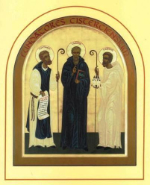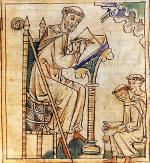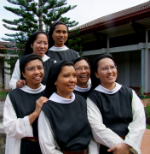We Cistercians of the Strict Observance derive our manner of living the Gospel of Jesus Christ and our spirituality from the following five sources.
-
The Rule of Saint Benedict

Benedict
Our way of life is in substantial conformity with that mapped out in the Rule of Saint Benedict. The monks and nuns live in stable communities set apart from the ordinary life of society. Each day the full Liturgy of the Hours is celebrated in choir, beginning with the Office of Vigils some hours before dawn. The day is balanced between work, reading and study; communities are self-supporting and committed to offering hospitality to those who come in search of a spiritual ambience.
-
The Founders of Cîteaux.

Sts Robert, Alberic and Stephen
Sts Robert, Alberic and Stephen founded the reformed monastery of Cîteaux in 1098. Their aim was to refresh the institutional forms of monastic life and to bring them into closer conformity both with the Rule of Saint Benedict and with the aspirations of the age. In particular this involved an emphasis on authentic poverty and simplicity even in the liturgy, manual work, non-involvement in secular affairs, and, at the level of the Order, mutual concern and supervision among the different monasteries, as a means of maintaining fervor. The prime documents of this period are the Exordium Parvum, describing the origins of the reform, and the Charter of Charity, giving its constitutional basis.
-
Saint Bernard and his Contemporaries

St Bernard
The Cistercian charism evolved greatly during the second and third generations, particularly as influenced by Saint Bernard of Clairvaux (+ 1153). In this period there was particular interest in the interior or experiential quality of monastic life, and there was a new emphasis on the importance of both fraternal communion and contemplation.
-
The Reforms of Abbot Rancé

Armand Jean de Rancé
In the seventeenth century when various factors had caused decline and division in the Cistercian Order, the Abbot of La Trappe, Armand-Jean de Rancé initiated a strong reform movement, supported by his extensive writings and inspired by ancient monastic tradition. His principal emphasis was to insist on the austerity of Cistercian life and its contemplative character.
-
Post Conciliar Renewal

Matutum, Philippines
In the 25 years following the Second Vatican Council, the Order was engaged in renewing its Constitutions according to the spirit of the Council. This has resulted, in the first place, in a greater awareness and appreciation of the richness of its heritage of spirituality and practice and, secondly, in the recognition of the necessity of a greater degree of pluralism in order to facilitate inculturation and to allow the Cistercian charism to be lived in greater integrity in the many different parts of the world to which it has spread in recent times.
The Order is a monastic institute wholly ordered to contemplation.
Constitution 2





